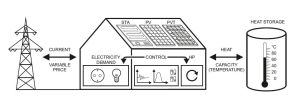The “Sol2Heat” project of Karlsruhe Institute of Technology (KIT) is aimed at coupling heat and power supply, both of which are to be based on renewable energy sources to a maximum extent. The system combines a heat pump with thermal solar collectors as the heat source, modular thermal storage systems, and photovoltaic modules. For this purpose, the scientists develop an integrated energy management scheme, by means of which local consumption is largely adapted to fluctuating power production and power costs that vary with time. “Sol2Heat” allows for the direct use of the electricity produced by photovoltaics and for reducing the grid load.
The increasing share of renewable energies in Germany is associated with big challenges in power supply. As power production from the regenerative sun and wind fluctuates with time, differences between supply and demand have to be balanced. Electricity can be stored in thermal storage systems charged by heat pumps.
The “Sol2Heat – Intelligent Production and Storage of Solar Heat and Power to Increase Solar Power Fractions in the Grid and Enhance Load Management” combines a heat pump-based heating system with photovoltaics and a smart control. “In this way, heating and power supply can be coupled, primary energy use can be minimized, and CO2 emissions can be reduced,” Project Head Tillman Faßnacht of the Building Science Division of KIT explains. The scientists connect the heat pump-based heating system with photovoltaic modules that convert solar energy directly into electric energy. Alternatively, they use PV/T modules combining photovoltaic cells with solar thermal collectors for the production of electricity and heat from solar energy. An innovative modular thermal storage system takes up excessive heat and keeps it available for use.
Moreover, the researchers develop an integrated energy management scheme. It covers all thermal storage systems, including the mass of the building, as well as the heat pump, the photovoltaic or PV/T system, and household appliances. Furthermore, it considers incentives of the utilities, such as power costs that vary with time. The work is aimed at maximizing the share of solar power in the energy supply of the building, minimizing operation costs, and reducing grid load. Both energy supply of the individual building and integration into the entire energy system based on renewable sources benefit from the smart combination of technologies.
Within the framework of the project, the simulation study made focused on the use of PV or PV/T modules in the system envisaged. According to the study, use of PV/T modules instead of solar thermal/air collectors applied so far causes the power consumption of the system to increase. But thanks to electricity production by PV/T, the resulting annual power consumption from the grid is far smaller. The basic control strategy designed for coupling the system with PV/T collectors ensures optimum storage of locally produced power in the form of heat.
The “Sol2Heat” project is coordinated by the Building Science Division of KIT. Project partners are Consolar (www.consolar.de), a manufacturer of heating systems, the engineering office Bickele & Bühler (http://ibb-stuttgart.de/), and the Research Center for Information Technology (FZI; www.fzi.de). The project is funded by the Federal Ministry for Economic Affairs and Energy (BMWi).
The Karlsruhe Institute of Technology (KIT) is one of Europe’s leading energy research establishments. Research, education, and innovation at KIT foster the energy turnaround and reorganization of the energy system in Germany. For this, KIT links excellent competences in engineering and science with know-how in economics, the humanities, and social science as well as law. The activities of the KIT Energy Center are organized in seven topics: Energy conversion, renewable energies, energy storage and distribution, efficient energy use, fusion technology, nuclear power and safety, and energy systems analysis. Clear priorities lie in the areas of energy efficiency and renewable energies, energy storage technologies and grids, electric mobility, and enhanced international cooperation in research.
In close partnership with society, KIT develops solutions for urgent challenges – from climate change, energy transition and sustainable use of natural resources to artificial intelligence, sovereignty and an aging population. As The University in the Helmholtz Association, KIT unites scientific excellence from insight to application-driven research under one roof – and is thus in a unique position to drive this transformation. As a University of Excellence, KIT offers its more than 10,000 employees and 22,800 students outstanding opportunities to shape a sustainable and resilient future. KIT – Science for Impact.

